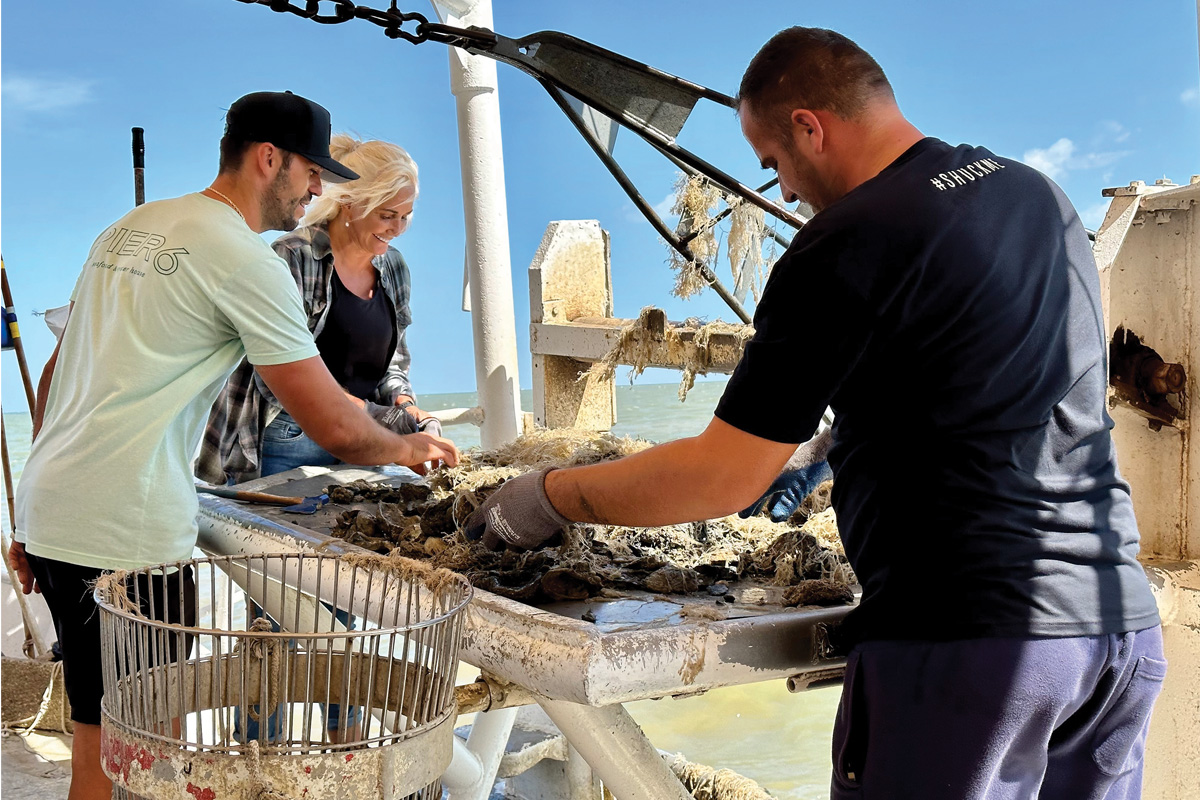Building Sanctuary
Words by MM Pack | Photo by Kimberly Park
One cloudy day in September, a small group of people steadied themselves on The Sundowner, a Gulf oyster boat, as it rocked gently above an oyster bed a quarter-mile from the San Leon shoreline. In addition to Captain Humberto Jiron and Captain Gezim Halili of Prestige Oysters Inc., Kathy Sweezey from The Nature Conservancy and Madgellen Cleary of Texas Sea Grant, a program of Texas A&M University, were onboard to perform the quarterly monitoring of the undersea oyster culture in the 10-acre plot known as Rett Reef. The monitoring is part of an ongoing collaborative project to restore this reef to a healthy, productive state and help increase the oyster population in Galveston Bay.
Methodically following a grid pattern, Jiron and Halili raked up samples of oysters from each sector and assisted Sweezey and Cleary in measuring the water quality and counting and sizing live oysters and the oyster spat (larvae) attached to the shell and rock substrate on the seafloor. The samples are then returned to the water, and the recorded data is later analyzed to determine the reef’s restoration progress and help develop best practices for future projects. “The counting and sorting are the longest part of the process,” says Cleary.
For the past few decades, including the summer of 2024, the oysters and oyster fishing folk of Galveston Bay have taken a beating. Major weather events such as Hurricanes Ike, Harvey and Beryl have disrupted the critical balance of fresh and salt waters that oysters need to thrive. A series of extreme storms, tidal surges and torrential freshwater runoff have disturbed the soft bay floor, repeatedly covering oyster reefs with silty mud that smothers the oysters and greatly diminishing their reproduction. Consequently, the oyster fishing industry has suffered from a serious decline in the population of these popular bivalves, and the state has closed most publicly owned oyster reefs to harvesting to give the oysters time to regenerate.
This collaboration between Prestige and these two conservation groups reflects their mutual goal of fostering sustainable oyster culture and clean water quality in Galveston Bay. Oysters serve a fundamental role in coastal ecosystems: filtering their surrounding waters, providing habitat for other marine life and reducing coastal erosion. “All of us want the same thing — a healthy bay,” says Sweezey.
First conceived in 2016, Rett Reef is a passion project for Lisa Halili — Gezim’s aunt, co-owner of Prestige Oysters and founder of the non-profit San Leon Oyster Fest. Her aim is to rebuild the former San Leon Marina Reef that was destroyed by Hurricane Ike in 2008.
With help from Texas Sea Grant and The Nature Conservancy, the San Leon Oyster Fest organization leased the area of the defunct reef from the state and re-established it as a protected reef to serve as a non-harvestable oyster nursery that will boost repopulation. In honor of another of her philanthropic interests, Lisa renamed the site Rett Reef to help increase public awareness of Rett Syndrome, a debilitating genetic disorder that affects young children’s brain development.
To jumpstart the reef’s regeneration process, Pier 6 Seafood & Oyster House in San Leon — a restaurant owned by Lisa’s son Raz Halili — collected and cured 1,300 tons of oyster shells beginning in 2020. In April 2024, this mountain of recycled shells was loaded by Prestige equipment onto the company’s boats, ferried out to the reef site and spread over the sea floor using an onboard water cannon. This shell substrate allows free-floating oyster spat to permanently attach, grow and reproduce. Oysters not harvested grow bigger and produce more spat, which ride the currents and attach to other reef locations, further increasing Galveston Bay’s oyster populations.
“It’s expensive to set up and maintain an oyster reef,” says Lisa. “This sanctuary project — I call it a spat bank — could not have happened without the cooperation of the Pier 6 restaurant with their source of oyster shells, and the use of Prestige’s equipment and boats to transport the shells to the reef site.” The project partners and donors will continue to spread substrate material over time, gradually building up the depth of the reef, and the conservation groups will continue to monitor progress for the foreseeable future.
In the past, Prestige has done similar reef restoration and maintenance on their privately leased oyster-harvesting reefs in Texas and Louisiana. The difference this time is that Rett Reef is not a commercially motivated enterprise. It is the first non-harvestable sanctuary project in Texas to be spearheaded by a private-industry entity, rather than the state or a nonprofit conservation organization.
“We’re fortunate to be collaborating with Prestige on Rett Reef,” says Sweezey. “They have deep knowledge of local marine conditions and experience in managing oyster reefs. We combine this hands-on knowledge with our scientific data gathering and analysis to develop what we call adaptive management practices, adjusting and improving how we do things in future reef restorations.”
Gezim explains that maintaining an oyster lease is not unlike a farmer cultivating the land so that crops continue to grow and thrive. “People think that oyster fishermen just go out and scrape up all the oysters off the bottom. That isn’t the case,” he says. “When we fish a reef, we remove the mature oysters to allow the undersized to get more nutrients, then we leave the reef alone for a few months.” One of the various roles that Gezim performs for Prestige is maintaining the harvesting and regenerating cycles for the company’s many oyster leases.
Prestige, one of the largest oyster companies in the country, was founded by Lisa and her husband Johnny Halili — a farmer’s son of Albanian descent who immigrated from war-torn Kosovo in 1976. An American success story, today the business they founded includes numerous members of their immediate and extended family, maintains 50,000 acres of oyster leases in Texas and Louisiana, and provides a market to as many as 100 oyster boats. The company also provides hundreds of coastal jobs in oyster fishing, processing and distribution.
The Halili family’s commitment to marine conservation did not begin with Rett Reef, either. In addition to conscientiously maintaining its oyster leases for health and growth, Prestige went through a rigorous three-year process led by Raz to become the first North American oyster fishery certified by the Marine Stewardship Council, a global nonprofit that promotes sustainably fished seafood.
The good news coming from the past two quarters of monitoring Rett Reef is that the numbers are slowly increasing for live oysters and attached spat. After a very tough summer for Galveston Bay oysters, the situation is far from ideal but, if Mother Nature cooperates, the project collaborators are cautiously optimistic that the managed success of this sanctuary reef will increase the oyster population, contribute to the continued health of Galveston Bay, and support the future of the oyster industry. “I’m an oysterman and in it for the long haul,” Gezim says. “I plan to pass the trade on to generations to come.”





